HelloJetlag has a new URL!!
For updates on our most recent adventure please visit http://www.hellojetlag.com.
See you there 🙂
HelloJetlag has a new URL!!
For updates on our most recent adventure please visit http://www.hellojetlag.com.
See you there 🙂
When I was in first grade, I learned about the Amazon rainforest. Like most 6 year olds, I could not fully understand the complexity of such a place, but for some reason I was able to grasp just how powerful this special area of the world was. The vision of dense canopies, wildlife I never even knew existed, and the fact that it contributes roughly 20% of Earth’s oxygen made it untouchable. I imagined the plants glittering and animals smiling; it was perfect.
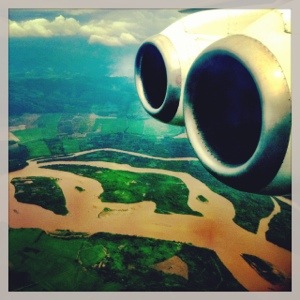
I drafted this post in the Lima airport before I even stepped foot in the jungle. I was so certain that the Amazon would meet my 6 year-old mind’s expectations that I typed out this sentence.. “It is just as, if not more magical.” Reality has a way of knocking you to your knees. From the outside, it seems as if this city prides itself on the diverse plants and wildlife, but when you really get to know it, the secrets slowly begin to unfold.
During that same day in first grade when we learned about the beauty of the rainforest, we also discovered it’s pain. The damage due to deforestation and animal extinction is increasing and we are losing precious flora and fauna by the second. I cried every night for the next week.
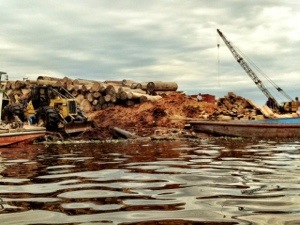
Fast forward 19 years, and I am still crying. The stories you hear about the Amazon are real and I have had to experience them first-hand every single day for the past month. At night I cringe as rifles fire in the distance. In the day, chainsaws echo in the forest, and trees can be heard crashing to the ground. In the markets, beautiful endangered creatures are laid out for sale, alive and dead, without so much as a raised brow from anyone passing by.
While the Peruvians we have come across have been extremely hospitable and friendly, I have never been more disappointed by a community. I’ll never un-see people aimlessly throwing their plastic bottles and trash into the Amazon river. Ill never un-know the family with a malnourished baby capuchin tied to a post in their backyard, with rope so tight around his waist that his hair was falling out. I’ll never un-hear children laughing as a pig was slaughtered on the docks of the port.
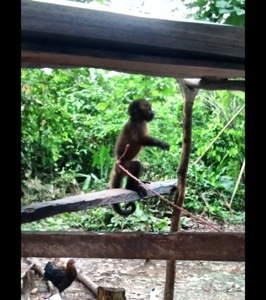
Tourists travel thousands of miles for a chance to encounter the incredible animals they’ve only seen in photos. Unfortunately, the only way to actually see animals here are in domestic conditions. There are three legitimate animal rescue centers which are working for the animals but unfortunately, others see the tourists flocking, and open up their own, inhumane tourist attractions for profit. Even the so called “eco lodges” buy animals to put in cages for their lobbies. Tourists want to see wildlife and Iquitos is providing it, no matter what the cost.
The ground belongs to Peru, Brazil and Ecuador, but I do not feel as if I’m visiting their land. There is only one Amazon and it belongs to all of us. I take it personally as I watch people toss their soda bottles off the side of the boat and it takes everything in me to keep from pushing them along with it. At least in time, they’d begin to decompose, unlike their plastic which will live in the river forever. Here, this type of neglect impacts the source, unlike at home where it’s so much easier to utilize the motto “out of sight, out of mind.”
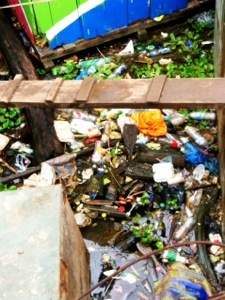
My journey to the Peruvian Amazon has been the single hardest trip I have ever taken, but the amazing memories I’ve made and the things I’ve experienced will stay with me forever. Last night, I took a moonlight canoe ride down the Amazon river, letting the infinite sounds of the jungle engulf me. I planted my very own trees, which will grow and live here for hundreds of years. I danced with indigenous people and rescued my very first monkey.
It really is one of the most enchanting places on earth. The plants do glitter, just as I imagined, when the sun hits the morning dew that has collected on their leaves. The animals on La Isla De Los Monos smile, because they are protected. There is magic in the smallest details; a delicate white butterfly with perfect black geometrical shapes adorning her wings, to the bird whose voice sounds exactly like a raindrop echoing through the trees, and the leaves that change from green to blue depending on what angle you look at them. It’s everything I’ve ever dreamed and unfortunately, everything I’ve ever feared.
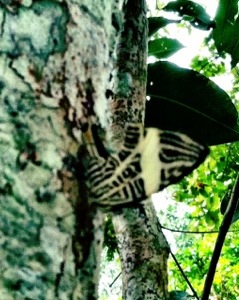
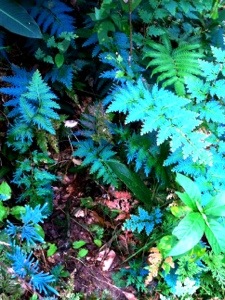
I have always fantasized about saving the world. Up until 4 weeks ago, I honestly believed I could. Unfortunately, the issues here (like most places) are too massive for one person, or even a generation to fix. The most critical resource that the Amazon needs is education (and considering the fact that most families here have 8+ children, birth control would help too). The people here are simply surviving, they are not concerned with long term consequences of their actions because they need to feed their families. Gilberto, our Peruvian host who has spent his entire life in the jungle, remembers catching hundreds of fish in the river, yet today, there are none. The fishing regulations are ignored and people fish year round, not realizing that by doing so, there will be less food on the table the following year. The same goes with hunting of wildlife. Children here do not look at the animals the same way we do; to them, they are food. As illegal as it is, nothing is being done to enforce these laws.
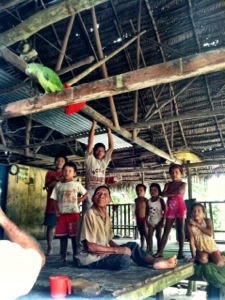
Part of me wants to fly home to Los Angeles right now, and revert back to the naïve life I used know. The one where you hear about the horrific things happening in the world and your heart breaks, but just for a second, until you close the newspaper or turn off the tv because it just cannot be as real as they say it is. Life was easier when the biggest issue I faced was whether or not an actress needed powder, and when I still believed I could fix the world.
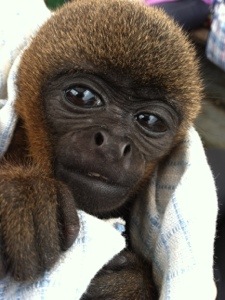
I will leave the Amazon rainforest broken, but not defeated. Although I could not save the Amazon (this time), I was able to save a life. Neeko, our malnourished baby woolly monkey, with ammunition in his tail and a broken foot would be dead by now if we hadn’t stepped in and nursed him back to health. Every life counts and I will spend the rest of my life trying to save as many as I can. My childhood dreamworld deserves that much
Gilberto Guerra Reátegui is the newest addition to my list of favorite people on earth. He is a shining light in the jungle who has dedicated the past 15 years of his life to preserving and protecting the monkeys of the Amazon.
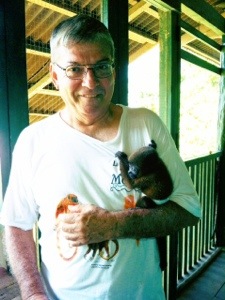
Every move Gilberto makes is for his monkeys. If we are sitting down to eat and Anita is hanging on the screen looking in, he gets up and feeds her. Several days a week he travels to different areas of the jungle to find bananas for them. His room is basically a monkey supply shed with a small bed tucked in the corner. He wakes up at 5am because they are hungry. He’ll stop his sentence and run outside if he hears so much as a whimper outside. Wherever we are on the island, we can hear Gilberto laughing and talking to his monkey children. His eyes light up when they are around and vice versa.
Gilberto possesses true passion for the animals on his island and he wants only the best for them. He talks about his visions for the future so fervently! He wishes to start an education program to teach the Amazon children about preserving these species. He dreams of hiring biologists to help him release monkeys in the Pacaya Samira reserve, the largest one in Peru. Unfortunately, to do so is expensive as the monkeys need check ups, shots and about 3 months of monitoring. Right now, his monkeys are free to migrate into the jungle on the 430 hectare island, and many do, however woolly monkeys become dependent on humans quickly and stay near the house for guaranteed meals. Also, the island is lowland rainforest and several species, such as the spider monkey, need to live on highland. Despite the many obstacles in his way, last year alone Gilberto rescued and released 85 monkeys and 20 sloths!

Most of the animal attractions in Iquitos run solely for profit. Gilberto welcomes tourists, though they are few and far between, but he makes it very clear that the monkeys are priority. Several days ago he went to Iquitos to buy a backpack. He came back with monkey food instead and told us he didn’t have enough money left over for his backpack this time. “Monkeys first,” he smiled.
Even though the reality of what’s happening to monkeys in the Amazon is overwhelming and tragic, Gilberto remains optimistic; he is never in a bad mood, and always giggling. Even when the monkeys get into trouble by sneaking into the kitchen or stealing our whole bag of fruit after we just spent an hour picking them, he laughs. Sometimes he’ll sigh and randomly remind us that he just really loves monkeys.
Gilberto has made our time in the jungle more special than I ever could have imagined. He takes us on jungle walks to eat fruit and look for sloths, he has us accompany him to the surrounding villages to introduce us to his friends, and on the way we spot pink dolphins. He shows us the best areas to gather good luck seeds, and he wakes us up at 4am to look at the full moon and stars from the dock. He is a special person full of life and light and he has welcomed us with both arms into his “monkey family.” In an area where very few are putting in any effort to protect the jungle, Gilberto is working his hardest to pick up their slack. He is the most selfless man I have ever had the pleasure of knowing. I’ve never met anyone with a heart as pure as Gilberto’s. Saying goodbye to him will be just as hard as saying goodbye to my monkeys.

On the plane to Iquitos we read about Masato, or “jungle beer,” in our Amazon survival book. Apparently, when you visit a tribe, they will offer you this beverage which you must drink, or it’s considered highly offensive. It’s ingredients are simple, chewed manioc (yucca) fermented with the yeast from women’s saliva.
“That’s disgusting! Thank god we won’t be put in that situation,” we said..
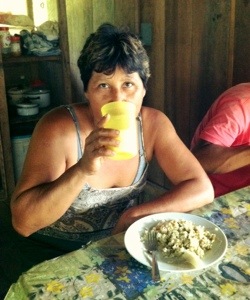
This afternoon during lunch, Melita pours herself a big cup of jungle beer and Gilberto asks if we want some. Thankfully we know him well enough that it didn’t offend him when we refused. We asked him who’s saliva goes in the beer and shrugged and said “village girl’s,” as if that would remove all hesitation. He cracked up at the faces we made as we watched Melita drink someone else’s spit.
When I’m in different countries, I always aim to taste the local beer. Since I’m not in the market for hepatitis, Amazon beer is one I’ll have to pass on.
It is illegal to possess or sell wildlife in Peru. However, spend 10 minutes in the market of Belen and you’ll see monkey babies, sitting next to their mother’s carcasses, both for sale. Nothing is being done to stop the illegal murdering and trafficking of the animals this city so proudly displays on the their brochures and flyers.
Hanging on the walls of the Ecological/Tourist Police Station in Iquitos are beautiful posters and paintings of wildlife. Directly beneath them, an officer refuses to file our complaint regarding the illegal activity we’ve witnessed. The only way for enforcement to be an option is if we bring a police officer to the specific area, then they must start an investigation which usually winds up with them being paid off. The police are 100% aware of what is happening in Belen; it is a “red zone” and if they enter, everyone puts their illegal items away so police don’t even bother. We talked to a local man that remembers seeing an officer playing with a sloth in the market.
The Peruvian government allows Gilberto to have 8 of the 28 species at the La Isla De Los Monos rescue center. If he brings additional species here, he will be fined. If he releases them into the wild without paying, he will also be fined. These are the issues the government chooses to care about. The other day we saw a baby capuchin monkey tied to a post. The rope was too tight on it’s waist and was rubbing him raw. There was absolutely nothing we could do as Gilberto is not allowed to bring this particular species to his island. Leaving that poor monkey was a horrificly hopless feeling.
At the station, we ended up leaving our complaint with the police chief. Even though nothing will be done over a single complaint, we wanted them to know we are disappointed in what we’ve seen. If more tourists and locals did this it, it would bring awareness to the fact that people are noticing and demand action.
How You Can Help
When I get home I will be uploading a printable complaint form in both Spanish and English. If you are traveling to Iquitos please sign it and bring it with you to turn it into the police station. It will take 10 minutes out of your day and could save a life, possibly even a species.
Police Ecologico
Sargento Lores #834
Iquitos, Peru
While we were on our overnight trip to Iquitos, we met several people who asked us what we were doing in the Amazon. We explained that we are volunteering at La Isla De Los Monos, a statement which was met with questionable glances.
“is that the place with the cages?”
“aren’t all the monkeys sick?”
“I don’t support that place.”
These were some of the responses we received, all from local people, including one tour operator! We explained what an amazing project it is and debunked the rumors they’ve been hearing. We also got to the bottom of why people thought of Monkey Island this way.
Turns out, there are two Monkey Islands, or “Isla de Los Monos” in Iquitos. The other one is only 10 minutes away (while the real one is 45min by speedboat) and the monkeys are kept in cages. It used to be called Las Boas but they changed their name to Monkey Island to draw in the tourists who want to come to the real Monkey Island. The animals aren’t treated that well. They have Boas which are kept in cages too small and many of them die from stress, then they are immediately replaced. The island operates solely to make money and the welfare of the animals comes second.
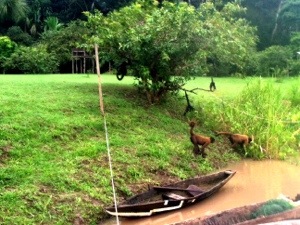
This is what’s happening:
Tourists hear about a rescue center for monkeys and decide to visit. At the port they tell the boat driver “la Isla de Los monos” and the drivers take them to the other Monkey Island 10 minutes away. The boat drivers are given a commission for bringing the tourists there. The tourists are unhappy with their experience and leave bad reviews for La Isla de Los Monos spreading the word that it’s not worth a visit. The people at the other Monkey Island also spread false rumors that the monkeys here are sick.
Gilberto, the owner of the real Monkey Island takes in sick and malnourished babies and rehabilitates them. They are given proper treatment and released on the island where they are free to relocate into the jungle. Many of them choose to remain near the house since they know food here is guaranteed. Many of the monkeys have gotten accustomed to humans and will play with tourists. It’s an amazing and rare opportunity to interact with monkeys in this way but it is not a tourist attraction. First and foremost it is a rescue center and the monkeys always come first. With that said, tourists are welcomed with open arms and they are needed. The entrance fee is 20 soles ($8) a person, and the money goes directly toward the care of the monkeys.
How to Get to the Real Monkey Island, Iquitos
If you are going to the real Monkey Island without a tour group, take a motokar to the Puerto de Productores (Producers Port), NOT Port Bella Vista-Nanay. Go through the market and down the rickety steps to the boats. Get on the speedboat to Mazan/Indiana (speedboats are leaving all day and there is no set time table). There are no ticket windows or signs, you pay the driver directly.
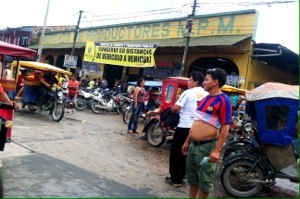
It’s best to call Gilbert before you come so he can arrange a small boat to pick you up in Mazan and take you across the river to the island. He speaks great English. If you don’t have a phone, email him but make sure to do it several days in advance, there is no wifi on the island. It takes 45 minutes to get to Mazan, exit the boat at the Mazan port and there should be a canoe boat waiting for you which will take you across the river to the island. It costs 13 soles (about $5) for the speed boat and 5 soles ($2) for the small boat to cross the river.
OR
You can take the slow boat (Cassandra) that leaves at 12 o’clock every day. It takes two hours but will drop you off right on the dock of Monkey Island. You will know have arrived because there’s a sign welcoming you to La Isla De Los Monos, and you’ll see monkeys playing in the distance. It costs 7 soles ($2.50) on the slow boat.
OR
You can rent a boat. Make sure you specify which Monkey Island because these drivers are usually the ones that make commission on the other location. Tell the boat drivers La Isla De Los Monos and mention Gilberto’s name. If you arrive in under 15 min you will know they have taken you to the wrong one.
If you have any questions, email me or write it in the comments!

I introduced you to Neeko almost 3 weeks ago after we rescued him from the market in Mazan (here). He had ammunition in his tail and side, a broken toe, was malnourished and terrified.
I am happy to announce that Neeko is recovering beautifully and gaining more strength every day. His tail and foot are still swollen, but his stitches are out and he is itching them a lot (a sign of healing). He has an enormous appetite and will maul a banana if he gets within 2 feet of one. Baby monkeys are similar to human babies, as they are in need of continuous care and attention. We can’t put him down or he cries, he has to eat every 3 hours and it seems like we are constantly changing his diaper.
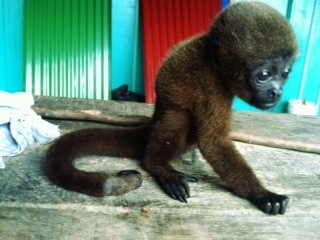
We have fallen head over heels with Neeko. I can’t stop looking at his tiny face, I feel like a new mom. He takes turns sleeping in each of our three beds and doesn’t leave our side all day.

Neeko is quite the ladies man, and has learned to give the best kisses! He reaches up, grabs your cheeks, pulls you in and then shoves his face in your mouth.
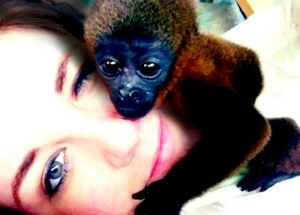
Leaving him behind is going to break my heart. Next time I see Neeko, he will be grown up and probably won’t remember me. He will forever hold a special place in my heart as the first (definitely not last) monkey I was able to save.
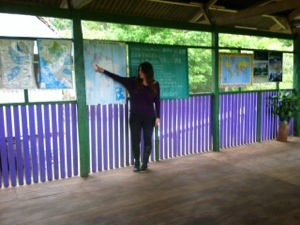
One of our most important volunteer tasks on La Isla De Los Monos is educating the tourists on the importance of Gilberto’s project. He speaks great English but since he is self taught, naturally there are language barriers.
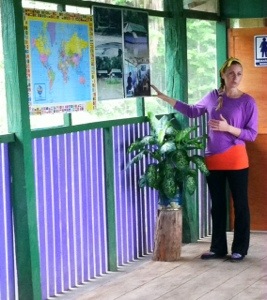
We have been communicating with English speaking tourists and answering any questions they have. We also teach them about the dangers monkeys are facing in the wild and encourage them to take action. We try and focus a lot on the younger visitors when it comes to education as they are the future and the ones who will, hopefully, begin to fix the problems we face today.
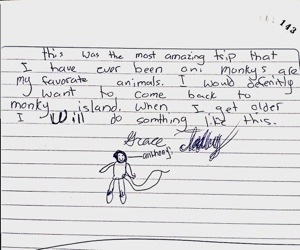
Monkey Island doesn’t have much of an online presence right now, so we also urge tourists to leave reviews on Trip Advisor and help spread the word . Many people have asked us what they too can do to help because they are touched by Gilberto’s vision. We’ve made a lot contacts and will be putting some things in action once we return home, in order to continue to help Gilberto even when we are not physically on the island.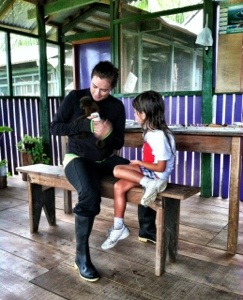
Marta and Melita are two women who live on La Isla De Los Monos and they have been our Peruvian mamas while we are living here. 90% of the time they can be found in the kitchen making the most delicious meals! They knew we were vegetarian and decided cook only vegetarian meals for the whole family while we are on the island!
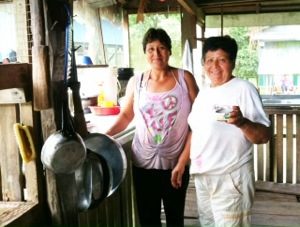
Marta is in charge of the food and she gives us breakfast, lunch and dinner without fail, even when we aren’t hungry. The majority of our food is fresh picked, organic vegetables. We eat a ton of tomatoes, broccoli, ginger, yucca root, potatoes and cucumber. I don’t know how she makes so many different dishes with the same ingredients, but not one meal has been a repeat and they are all delicious. She also fresh squeezes fruit to make us amazing juices.



Melita (the human, not the monkey) helps Marta in the kitchen, and she washes clothes. She laughs as she watches us try and hand wash our clothes in the sink and always redoes our subpar loads. Melita is a human washing machine!! Her hands single handledly create soap bubbles, then when she wrings them out, she does it so well that they are 80% dry before laying them out. She also does a lot of the planting and harvesting of vegetables on the island.
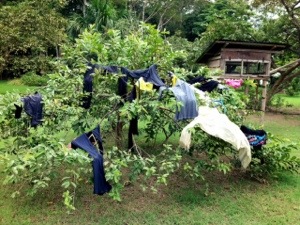
Neither Marta or Melita speak any English so we communicate with our broken Spanish and of course, a lot of pointing. Even though we don’t understand each other, they both have taken us in and accepted us as their family.
Since we’ve been here, they’ve learned their very first English words! Sugar, bread, fan and banana 🙂
The river is rising in the Amazon. Gilberto and many other families that live on it’s banks have been forced to cope with this reality. Last year, in May 2012 the water rose at record levels and flooded their home (which sits on 5ft stilts), destroyed the majority of their crops and took the lives of 9 monkeys. The damage is not easily forgotten, as the devastation continues to affect the family.
Monkeys eat a lot; on Monkey Island, they are fed four to five times a day. Since Gilberto’s crops were killed in the flood, he now has had to buy all of their food in Iquitos, at a 40% price increase. They have planted new fruit trees but it will take 12 more months to grow and start producing fruit.
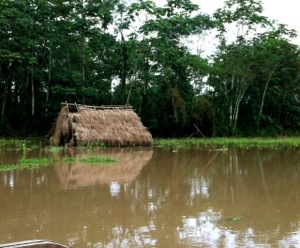
This was the rice shed of a neighboring family. A year later, it still remains underwater.
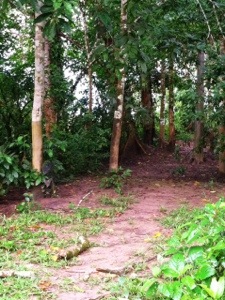
These trees show distinct marks, showing how high the water rose.
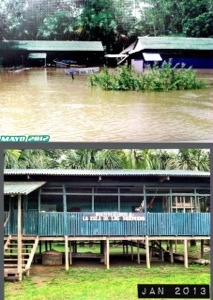
These photos show La Isla De Los Monos in May 2012 during the flood. The bottom photo shows what it looks like today.
In the few short weeks that we’ve been here, we have seen the water rise. Hopefully it will not reach the levels of last year.